Time is running out for the critically endangered vaquita. But we won’t give up on the survival of a species without a fight.

Preventing the extinction of the vaquita
Our campaign to save the vaquita
The vaquita: the world’s most endangered cetacean
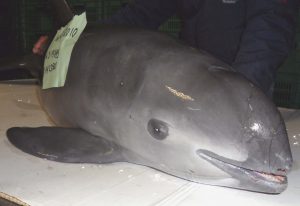
Vaquita (c) IUCN-CSG
The vaquita, a tiny porpoise species found only in the upper Gulf of California, Mexico, is the world’s most endangered marine mammal, with fewer than 10 individuals remaining.
The vaquita is not hunted in its own right – it is collateral damage, killed accidentally in the illegal gillnets set primarily for totoaba fish, the dried swim bladders, or maw, of which are highly sought-after in China.
For more than two decades, scientists have warned that the survival of the vaquita was dependent on eliminating bycatch in gillnets; however, action to enforce fishing bans has been largely ineffective. The Mexican shrimp industry was largely to blame for the loss of more than 70 per cent of the vaquita population from 1990 to 2010.
The resurgence of the illegal totoaba fishery since 2010 has accelerated the species’ race to extinction as organised criminal networks entered the market, seeking to profit from the high value of totoaba – itself a vulnerable species.
Hope for the future of the vaquita
In the short-term, the vaquita’s extinction is preventable only by eradicating illegal totoaba fishing and removing abandoned gillnets from their small remaining range. However, to date Mexico has completely failed to ensure a gillnet-free environment.
A recent expert report emphasised that “there is still hope” for the species, with the remaining animals still healthy and producing calves. But the vaquita will only be saved if their habitat is free of gillnets.
The endangered vaquita
-
567
vaquita
alive in 1999
-
< 10
vaquita
vaquita alive today
-
98.6 %
drop in numbers
of vaquita since 2011
Our work to save the vaquita
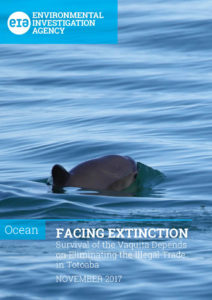 As part of our Ocean campaign, EIA is fighting to save the vaquita from extinction. Our work to save the vaquita includes:
As part of our Ocean campaign, EIA is fighting to save the vaquita from extinction. Our work to save the vaquita includes:
- drawing on the expertise and experience of our work with cetaceans (the collective term for whales, dolphins and porpoises);
- carrying out undercover investigations into the illegal totoaba trade;
- supplying information to enforcement agencies;
- urging Mexico to take action against illegal gillnet fishing and organised crime;
- applying pressure for action on the part of Mexico, China and the US;
- catalysing action at the International Whaling Commission and the Convention on International Trade in Endangered Species of Wild Fauna and Flora (CITES)
Saving whales, dolphins and porpoises
Our campaign to save the vaquita – a species of porpoise – is part of our ongoing work to save whales, dolphins and porpoises.
For more than four decades, EIA has fought to save whales, dolphins and porpoises. Our campaigns and investigations have enabled us to build up an in-depth knowledge of the issues involved and an extensive network of like-minded organisations around the world.
Our undercover investigators, campaigners and intelligence teams gather information about the extent of the threats to whales, dolphins and porpoises from commercial whaling and fishing to the dangers posed by marine plastic pollution, ship strikes and noise pollution.
With this information, we lobby governments, present recommendations to the International Whaling Commission (IWC) and CITES,and work with fellow NGOs to raise awareness and bring about change.
In April 2021, EIA joined other NGOs in calling for trade sanctions against Mexico under CITES for failing to halt illegal fishing, which is driving the vaquita, the world’s most endangered cetacean species, towards extinction.
Moving forward
The most recent report from the Comité Internacional para la Recuperación de la Vaquita (CIRVA), a team of scientists tasked with saving the vaquita, concluded that unless deaths in illegal gillnets are eliminated now, the vaquita will be extinct in a few years.
Our investigations have revealed that illegal totoaba fishing and trade is just the tip of the iceberg in the Upper Gulf of California. Criminal networks are stripping Mexico’s waters of many valuable marine species, including sea cucumbers, abalone and sea horses.
Mexico has carried out some enforcement actions, but against the scale of the challenge these have been woefully inadequate. Unless Mexico enforces a full gillnet ban and addresses the corruption and criminal networks perpetuating the illegal totoaba trade, there is no hope for the vaquita.
We will continue to monitor and investigate the illegal totoaba trade, applying pressure at the international level for greater action on the part of Mexico, China and the US.
Despite the very bleak outlook for the vaquita, any improvement in enforcement and governance will have multiple positive impacts on the conservation of threatened and endangered marine species in Mexico.
EIA reports on the vaquita
Over the years, we have produced a number of reports that reveal the increasing threat to the survival of the vaquita and call for action:
- On Borrowed Time; The ongoing illegal totoaba trade driving the critically endangered vaquita to extinction (2024)
- Ban Bycatch: The United States Must Ban Seafood Imports from Countries Failing to Protect Marine Mammals (2023)
Jointly produced by the Center for Biological Diversity, NRDC (Natural Resources Defense Council), Animal Welfare Institute and the Environmental Investigation Agency. - CITES’ Last Chance to Save the Vaquita (2019)
- Facing Extinction: Survival of the Vaquita Depends on Eliminating the Illegal Trade in Totoaba (2017)
- Collateral Damage: How Illegal Trade in Totoaba Swim Bladders is Driving the Vaquita to Extinction (2016)
- Dual Extinction: The Illegal Trade in the Endangered Totoaba and its Impact on the Critically Endangered Vaquita (2016)
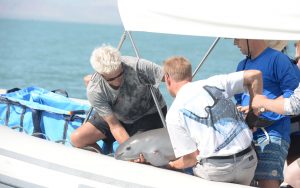
Vaquita calf recovery (c) VaquitaCPR
About the vaquita
The vaquita is the world’s smallest cetacean and its most threatened marine mammal. Also known as ‘vaquita marina’ or the Gulf of California harbour porpoise, it has the smallest geographical range of any marine cetacean species. The vaquita is found only in an area of about 4,000 sqe km in the Gulf of California.
With adults reaching about 1.5m in length and weighing 55kg, the vaquita is the smallest member of the porpoise family. Its conspicuous dark patches around the eyes and mouth make it one of the most iconic cetaceans.
Like its fellow cetaceans, whales and dolphins, the vaquita needs to come to the surface of the water to breathe. However, they are shy creatures that tend to avoid humans and vessels and are difficult to spot in the wild.
The vaquita’s diet consists of a variety of small fish species, as well as crustaceans, squid and octopus.
The water of the Gulf of California is murky and the vaquita uses echolocation to source food and find its way around. Only toothed cetaceans (some species of whale, all dolphins and all porpoises) can echolocate. The baleen species of cetaceans which have bristles instead of teeth, such as the blue whale, do not use this system.
The problem: illegal fishing and trade in totoaba
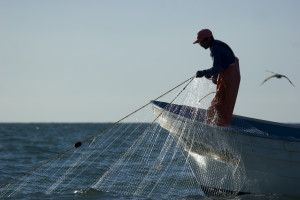
(c) Chris Johnson
The vaquita’s tragic decline is due to unintentional capture in fishing nets, or ‘bycatch’, with illegal gillnet fishing for totoaba fish being the key driver of the sudden and rapid decline in their numbers.
The swim bladder, or ‘maw’, of the large totoaba fish fetches high prices on the black market in China, where it is believed by some to have medicinal properties.
The future survival of the vaquita rests in the hands of a relatively small number of Chinese consumers of totoaba maw. While this lucrative market continues, vaquita will inevitably die in illegal fishing nets and dwindle to extinction.

Totoaba fish maw shown to EIA investigators in China (c) EIA
The totoaba ‘maw’: highly prized in China
The totoaba maw is a highly valued dried seafood item in China, alongside shark fin, abalone and sea cucumber.
The highest demand occurs in mainland southern China and Hong Kong, the latter being a well-established trading centre.
Fish maw is in demand for its supposed medicinal benefits and for use as a tonic, although scientific studies supporting these properties are lacking.
Mexico fails to enforce fishing ban
International trade in totoaba or any part of a totoaba has been illegal since 1977 under CITES.
Despite this ban, enforcement efforts have been completely ineffective.
Mexico has failed to address the illegal totoaba fisheries in the Upper Gulf of California.
Mexico’s efforts to protect the last remaining vaquita have fallen short on several other fronts. These include:
- loopholes in the gillnet ban which allow for mackerel and corvina fisheries that could be used as a cover for carrying and setting illegal gillnets;
- a failure to prohibit the possession, sale and manufacture of gillnets in the area;
- lack of control or monitoring of fishing;
- delays in the development of alternative fishing gear and in permitting the use of available alternative gear.
The development of alternative livelihoods in the region has equally shown little progress.
Despite recent new regulations intended to control fishing activities in the area and some limited seizures of totoaba swim bladders and arrests of totoaba poachers, illegal fishing continues unabated with virtually no evidence of meaningful enforcement.
Gulf of California on ‘danger’ list
The unchecked decline in the vaquita resulted in a decision by the World Heritage Committee (WHC) to list Mexico’s Islands and Protected Areas of the Gulf of California as a World Heritage site in danger in 2019.
The area of 244 islands, islets and coastal areas became a World Heritage site in 2005 for its exceptional marine biodiversity. It is home to 39 per cent of marine mammal species and a third of the world’s cetacean species, including the endemic vaquita. Both the vaquita and totoaba are designated as species of “Outstanding Universal Value” by the WHC.
The World Heritage in Danger listing is a mechanism designed to facilitate emergency conservation action and international assistance to support severely threatened World Heritage sites. For the area to be removed from the ‘in danger’ list, Mexico must work with the UN Educational, Scientific and Cultural Organisation (UNESCO) to develop corrective measures to save the vaquita.
Our investigations into the illicit totoaba trade
A series of undercover investigations conducted by EIA since 2015 in southern China and Mexico reveal a persistent illicit trade in totoaba maws, with the black market being supplied by criminal syndicates spanning both the source country and main markets.
Cartels and corruption
Our investigations reveal that fresh totoaba maws are sourced from a cartel in Sinaloa state, Mexico, whose operations have been linked to kidnapping, murder and the drug trade.
Corruption is commonplace and enables the illegal trade to flourish, with one instance of a trader’s friend being caught with 40kg of totoaba maw and paying a bribe of $200,000 to avoid arrest.
EIA investigators were told that one criminal group was looking to expand the business by purchasing 11 fishing boats to increase supply.
Transport routes
Once the fresh maws arrive at the factory in Mexico City, they are dried and shipped overseas via air freight, often concealed among legitimate marine products.
Chinese nationals in Mexico are recruited to transport dried totoaba maws in suitcases, usually via indirect routes including South Korea, Vietnam and Japan. A shipping agent in Hong Kong is able to move the maws into mainland China.
An urgent need for action
At a CITES meeting in late 2017, Mexico announced its support for a high-level diplomatic mission to Mexico with a view to addressing the urgent conservation status of the totoaba and vaquita. The mission did not take place until May 2019. During those 18 months, the vaquita population declined by at least 48 per cent.
In our 2019 report, CITES’ Last Chance to Save the Vaquita, Clare Perry, our Ocean Campaigns Advisor said: “The apathetic response to the CITES decisions on the vaquita and totoaba is inexcusable in the face of the looming extinction of the vaquita.
“This is the last chance for CITES to spur real action to save the vaquita – because unless the illegal fishing and illegal trade driving it are stopped, there will simply be no vaquita left in existence at the next Conference of the Parties in 2022.
That will be on us, a major extinction on our watch at the hands of criminals and CITES must take the strongest possible steps at this meeting to avert such an outcome.
Preventing extinction of the vaquita
We called for Mexico to take urgent action, including:
- ensuring protection of the remaining vaquita by maintaining a net-free zone in the small area that the few remaining vaquita inhabit, with constant surveillance by sufficiently resourced and armed personnel to respond to any attempts to set gillnets and with the authority to arrest anyone violating Mexican law;
- increasing enforcement on land and in water to eliminate all setting of gillnets in the range of the vaquita and to seize all gillnets;
- ensuring totoaba fishers and traffickers are prosecuted, with the application of penalties that are sufficient to deter continued criminal activities;
- fully funding and expanding the net removal program and ensuring the protection of net removal teams;
- strengthening existing laws to prohibit the sale, possession and manufacture of gillnets in the Upper Gulf (on land and water);
- strengthening collaboration with law enforcement authorities in totoaba demand and transit countries, including China, the US, South Korea and Vietnam.
Mexico, the US and China must work together
To save the vaquita, we need international co-operation between countries, law enforcement and NGOs.
EIA Oceans Campaign Advisor Clare Perry says:
To have any hope of recovery, we need to stop the bycatch of vaquita in gillnets. Mexico cannot do this alone – China must significantly ramp up efforts to address the market for totoaba maw and work with Mexico, the US and other countries to clamp down on the illegal international trade in totoaba.
How you can help us save the vaquita
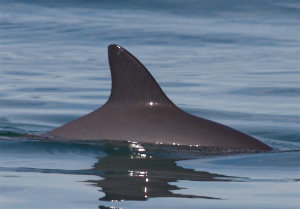
The near-extinct vaquita (c) Thomas A. Jefferson
Despite the bleak outlook for the vaquita, we will not give up on the survival of a species without a fight. We will continue to research and investigate the illegal totoaba trade and apply pressure at the international level for greater action from Mexico, China and the US.
Any improvement in enforcement and governance will enhance the conservation of all threatened and endangered marine species in Mexico, not just the vaquita.
The story of the vaquita should serve as a grave warning for other endangered marine species, including many coastal small cetacean species that are subject to direct hunts, bycatch and other threats. We must not stand by as these creatures continue to die on our watch.
Please donate today to support our vital work for the protection of marine life and to stop wildlife and environmental crimes around the world.

